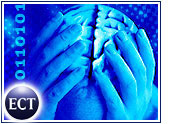
New research has suggested that technology-based, non-invasive and drug-free techniques may be effective at relieving pain for some migraine sufferers, according to a study presented at the annual American Headache Society meeting in Boston.
The treatment used in clinical trials conducted by Dr. Richard B. Lipton, a researcher in the cause and treatment of migraines, utilized a portable transcranial magnetic stimulation (TMS) device to treat patients suffering from migraines with auras, perceptual disturbances that warn of oncoming episodes in some sufferers.
Medical Technology on the Bleeding Edge
The device used by Lipton addresses a problem more often treated by drugs. People who frequently experience migraines may receive a preventative drug. Those who have migraines periodically may take both a preventative as well as an acute drug taken at the time the headache appears.
In fact, acute drug therapy, typically a class of agents known as “triptans,” is the most common form of migraine treatment. However, only 50 to 60 percent of migraine sufferers in the U.S. respond favorably to prescription drug-based treatments.
Some migraines are preceded by a sensory event known as an “aura.” Patients within this category of migraine sufferers — roughly 30 percent — describe seeing flashing lights or shooting stars and may also experience tingling, prickling or numbness in their fingers followed by intense pain, nausea, sensitivity to light and sound and even vomiting.
“For some, that’s a signal to them that the pain is going to hit soon. Most people who get this particular type of headache don’t have the aura, but there is a subset that does,” said Dr. Linda Porter, program director at the National Institute of Neurological Disorders and Stroke at the National Institutes of Health, who said she has not had an opportunity to examine the study’s results in detail.
The aura, Porter told TechNewsWorld, is now thought to be a trigger for the pain.
“Through scientific study we recognize the aura to be … a wave of excitability and then inhibition in cortical electrical signaling, and that can occur in different places in the brain. For some people, this occurs in the visual cortex, and the person will have a visual event. If it happens in the part of the brain where touch sensation is processed, then they may get tickling or tingling. But it is basically that wave that they think irritates the nerves that supply the coverings over the brain — meninges. That’s where the headache occurs. Those nerves carry the pain sensation,” she explained.
Magnetized Pulse
The device, developed by Neuralieve, a medical technology company, works by creating a focused magnetic pulse that passes non-invasively through the skull and induces an electric current that sends signals to disrupt the abnormal brainwaves.
“My understanding is that this device is trying to stop that cortical spreading depression or that wave of electrical signaling in the brain. The device would be applied at the time of the aura, so it would be an acute treatment, not a preventive treatment. People would have to apply it each time they get a migraine,” Porter pointed out.
If it works, it seems like it would alleviate the pain very quickly, Porter noted, but the user would have to know when an aura was coming or have the device with him or her at the time of the aura to hopefully prevent the headache.
The TMS-based device would not replace use of all migraine drugs, but it could replace the use of some drugs for some individuals, she acknowledged.
“It looks like it has some effectiveness. Whether this is going to replace all medications for all people, I think we’re getting ahead of ourselves to say something like that. But [from the information available], it looks like it has potential,” Porter said.
Lots of Pain for Lots of People
An estimated 30 million Americans suffer from migraines, with more than 50 percent reporting severe impairment or requiring bed rest during an episode. The National Headache Foundation estimates that migraines cause 157 million lost work days each year due to pain and accompanying symptoms. The missed days cost employers some US$13 billion annually.
“Migraines are very common. They are more common in women than men and we’re not sure exactly why that is,” said Porter.




















































